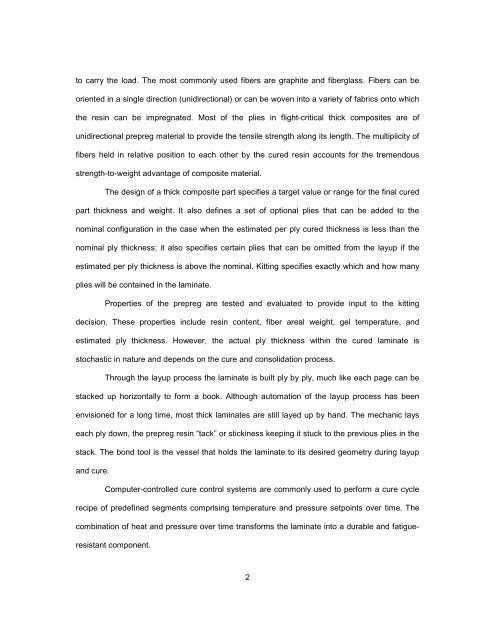TOOLED THICK COMPOSITES by ARVEN H. SAUNDERS III ...
TOOLED THICK COMPOSITES by ARVEN H. SAUNDERS III ...
TOOLED THICK COMPOSITES by ARVEN H. SAUNDERS III ...
Create successful ePaper yourself
Turn your PDF publications into a flip-book with our unique Google optimized e-Paper software.
to carry the load. The most commonly used fibers are graphite and fiberglass. Fibers can be<br />
oriented in a single direction (unidirectional) or can be woven into a variety of fabrics onto which<br />
the resin can be impregnated. Most of the plies in flight-critical thick composites are of<br />
unidirectional prepreg material to provide the tensile strength along its length. The multiplicity of<br />
fibers held in relative position to each other <strong>by</strong> the cured resin accounts for the tremendous<br />
strength-to-weight advantage of composite material.<br />
The design of a thick composite part specifies a target value or range for the final cured<br />
part thickness and weight. It also defines a set of optional plies that can be added to the<br />
nominal configuration in the case when the estimated per ply cured thickness is less than the<br />
nominal ply thickness; it also specifies certain plies that can be omitted from the layup if the<br />
estimated per ply thickness is above the nominal. Kitting specifies exactly which and how many<br />
plies will be contained in the laminate.<br />
Properties of the prepreg are tested and evaluated to provide input to the kitting<br />
decision. These properties include resin content, fiber areal weight, gel temperature, and<br />
estimated ply thickness. However, the actual ply thickness within the cured laminate is<br />
stochastic in nature and depends on the cure and consolidation process.<br />
Through the layup process the laminate is built ply <strong>by</strong> ply, much like each page can be<br />
stacked up horizontally to form a book. Although automation of the layup process has been<br />
envisioned for a long time, most thick laminates are still layed up <strong>by</strong> hand. The mechanic lays<br />
each ply down, the prepreg resin “tack” or stickiness keeping it stuck to the previous plies in the<br />
stack. The bond tool is the vessel that holds the laminate to its desired geometry during layup<br />
and cure.<br />
Computer-controlled cure control systems are commonly used to perform a cure cycle<br />
recipe of predefined segments comprising temperature and pressure setpoints over time. The<br />
combination of heat and pressure over time transforms the laminate into a durable and fatigue-<br />
resistant component.<br />
2
















